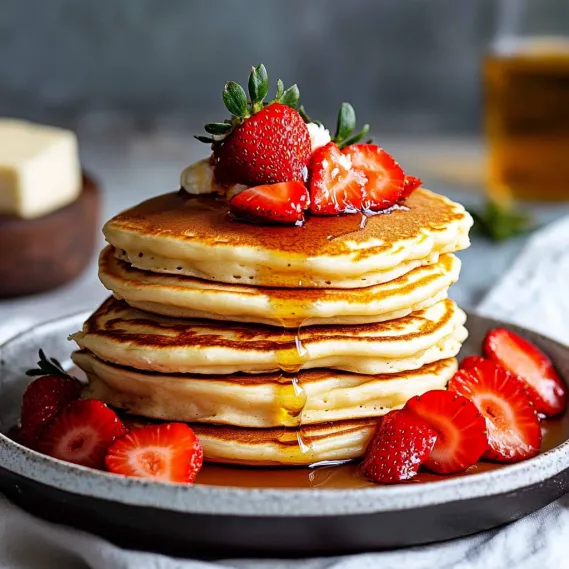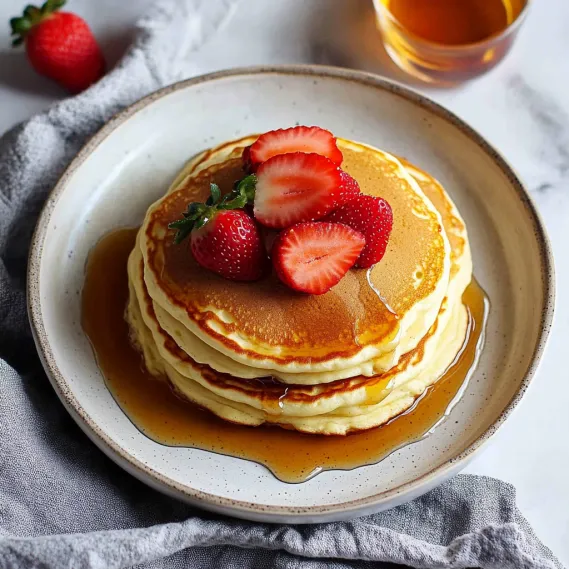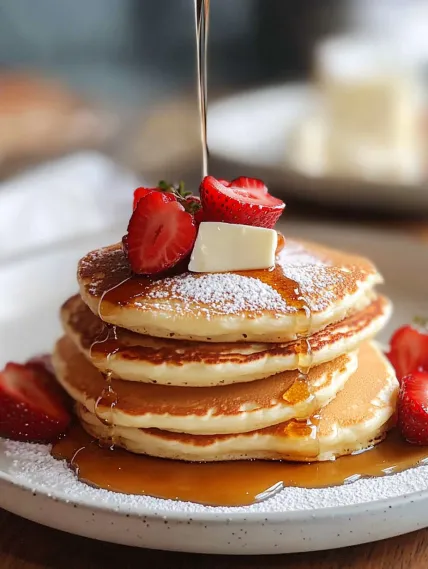 Pin it
Pin it
This ricotta pancake recipe transforms ordinary breakfast into a luxurious morning treat with its cloud-like texture and subtle richness. The secret lies in the perfect marriage of ricotta cheese with traditional pancake ingredients, creating a breakfast worthy of a gourmet café right in your own kitchen.
I discovered these pancakes during a rainy Sunday morning when I needed something special to brighten our day. After the first batch, my family declared them our official weekend tradition, requesting them nearly every Saturday since.
- Ricotta cheese: Adds moisture and creates those signature pillowy pockets throughout each pancake
- Large eggs: Provide structure and help the pancakes rise beautifully
- Caster sugar: Offers just the right sweetness without being overwhelming
- Milk: Creates the perfect batter consistency while adding richness
- Vanilla extract: Enhances the flavor profile with subtle warmth
- White vinegar: Activates the baking soda for maximum fluffiness
- Plain flour: Forms the foundation of the pancake structure
- Baking powder and baking soda: Work together as leavening agents for incredible rise
- Salt: Balances the sweetness and enhances all other flavors
- Butter: Adds richness and prevents sticking while creating a beautiful golden crust
- Fresh strawberries: Provide bright juicy contrast to the warm pancakes
How To Make Fluffy Ricotta Pancakes
- Prepare the wet mixture:
- Whisk ricotta, eggs, sugar, milk, vanilla, and vinegar until well combined but still showing small curds of ricotta throughout. The texture should be relatively smooth but not completely homogeneous. The small ricotta bits create those heavenly pockets of creaminess.
- Incorporate dry ingredients:
- Scatter flour, baking powder, baking soda, and salt over the wet mixture, then whisk until just combined. Take care not to overmix as this develops gluten and makes tough pancakes. The batter will be slightly thicker than regular pancake batter with a rich, creamy consistency.
- Heat the cooking surface:
- Warm your nonstick pan over medium heat until properly hot, about 2 minutes. The right temperature is crucial. Too cool and pancakes will be dense and undercooked, too hot and they'll burn before cooking through. Apply a light coating of melted butter to prevent sticking.
- Pour and cook first side:
- Measure 1/4 cup batter for each pancake, pouring it gently onto the hot surface. Allow it to naturally spread into a round shape, about 5 inches in diameter. Cook for exactly 1 1/2 minutes until the surface shows tiny bubbles and the bottom turns golden brown.
- Flip and finish cooking:
- Carefully flip each pancake with a thin spatula, supporting the full surface. Cook the second side for another 1 1/2 minutes until golden and completely set. The pancake should spring back when gently pressed in the center, indicating it's cooked through.
- Stack and serve immediately:
- Transfer cooked pancakes to a warmed plate, stacking them to preserve heat. Continue cooking remaining batter, applying butter only as needed. Serve with macerated strawberries, quality maple syrup, and perhaps a dusting of powdered sugar.
 Pin it
Pin it
The ricotta is truly the star ingredient here. I once tried substituting cottage cheese in a pinch, and while the pancakes were good, they lacked that distinctive light, airy quality that makes these so special. My daughter now requests these for her birthday breakfast every year, calling them "cloud cakes" because of their incredible texture.
Temperature Control Matters
Managing your stovetop heat is crucial for ricotta pancake success. These thicker pancakes need consistent, moderate heat to cook through properly without burning. I recommend starting at medium heat and adjusting slightly lower as your pan naturally gets hotter with each batch. If your pancakes are browning too quickly, reduce heat immediately. A properly cooked ricotta pancake should have a golden-brown exterior and a fully set but moist interior.
Make Ahead Options
While these pancakes are best enjoyed fresh off the griddle, you can prepare components ahead of time. Mix the dry ingredients the night before and store in an airtight container. The wet ingredients can be combined and refrigerated separately. In the morning, simply combine them and cook. Leftover cooked pancakes can be refrigerated for up to two days or frozen for a month. Reheat in a toaster or warm oven for a quick breakfast that still maintains much of the original texture.
 Pin it
Pin it
Perfect Pairings
These ricotta pancakes pair beautifully with more than just the suggested strawberries. Try them with caramelized bananas, mixed berry compote, or even a dollop of lemon curd for a bright, tangy contrast. For a more decadent treat, add a scoop of mascarpone cream or a drizzle of warm chocolate sauce. The subtle cheese flavor in the pancakes creates a wonderful canvas for both sweet and slightly savory toppings. My personal favorite is to serve them with honey-roasted pears in fall or fresh peaches in summer.
The texture of these ricotta pancakes makes them stand out from any ordinary breakfast. Their pillowy centers with tiny pockets of creamy richness transform a simple morning meal into something truly special. Whether for a lazy weekend breakfast or a holiday brunch, these pancakes consistently impress even the most discerning breakfast enthusiasts.
Frequently Asked Questions
- → What makes ricotta pancakes different?
Ricotta pancakes are extra soft and fluffy due to the addition of ricotta cheese. This ingredient gives them a moist, tender texture that elevates them over traditional pancakes.
- → How can I ensure the pancakes cook evenly?
Control the stove temperature to medium heat. Aim for about 3 minutes cooking time on each side for golden crusts and fluffy interiors.
- → Can I substitute ricotta cheese?
Yes, you can try cottage cheese blended until smooth or Greek yogurt as a substitute. However, the texture may slightly vary.
- → What toppings pair well with these pancakes?
Macerated strawberries, maple syrup, and a dollop of whipped cream or softened butter are ideal. You can also add fresh berries or powdered sugar.
- → Can I prepare the batter ahead of time?
It's best to make the batter fresh. However, you can whisk the wet and dry ingredients separately the night before and combine them in the morning.
